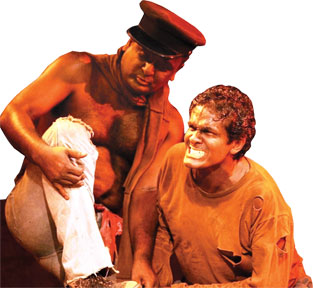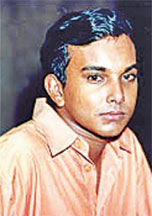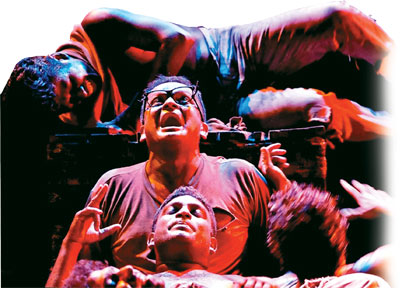Asinamaali Dreams of an escape
By Dilshan Boange
The magic of the proscenium theatre is that it is a ‘place’ defined
in its ‘spatial dimensions’ yet able to create ‘domains’ through
‘expressions’ that transcend parameters of chronology and geography.
Tales of myth and legend to topics hot in the news, the theatre is a
space where the communication desired by the artist to his audience is
channelled through the medium of ‘live performance’.
 On December 24 seated in the gentle darkness of the Punchi Theatre in
Colombo I watched a Sinhala rendition of the South African play
Asinamaali by Mbogani Negma, adapted and directed for the Sri Lankan
theatregoer by Pujitha de Mel who must be commended for putting on a
praiseworthy production which had in its cast, Priyankara Ratnayake,
Dharmapriya Dias, Vishwajith Gunasekera, Sanjaya Hettiarachchi and
Nishanka Madularachchi. On December 24 seated in the gentle darkness of the Punchi Theatre in
Colombo I watched a Sinhala rendition of the South African play
Asinamaali by Mbogani Negma, adapted and directed for the Sri Lankan
theatregoer by Pujitha de Mel who must be commended for putting on a
praiseworthy production which had in its cast, Priyankara Ratnayake,
Dharmapriya Dias, Vishwajith Gunasekera, Sanjaya Hettiarachchi and
Nishanka Madularachchi.
It can be appreciably noted for its success as an adaptation which
presents the socio-political and cultural landscape the original work
represents, and in fact seeks to communicate while having a distinct
closeness to the local audience through the Sinhala language.
Idiomatic language and colloquy
Overdoing the thrust for connectivity and going overboard with zeal
to make it appeal to our lingual form, a translator could be driven to
‘localise’ the stylistics of speech and dialogue to an extent that the
story almost seems like it was one that happened in Sri Lanka when
paying attention to idioms and colloquy that colour the diction of the
characters.
Yet there can be some noticeable incongruousness when a ‘pristine’
Sinhala speech pattern comes out of characters who communicate of
places, names, and incidents that are utterly unrelated and far removed
from our own milieu and claim to represent another culture.
The translated script of Asinamaali has successfully blended these
different ‘interests’ from my observations of the performance, since I
did not distinctly recall dialogues peppered with Sinhala idioms or
metaphoric expression to the extent that makes the Sinhala translation
and the English text of the play that would undoubtedly show
discrepancies that would raise concerns in terms of ‘transliteration
integrity’, on the part of the ‘adaptor’.
There was colloquialism in the form of certain contemporary slang and
expletives at times which due to the right timing and context made it
function as very direct expressions of the ‘emotion content’ contained
in that character and the moment as opposed to a larger cultural
connotation or culture specific idiom that would conjure an image that
posits the essence of the communication to be strictly limited to our
local sensibilities.
An example to this effect from the English language would be the
saying –‘Carrying coals to Newcastle’ if used to express a Sinhala
consciousness. This turn of phrase while known for its worth as
idiomatic language rooted in the English ‘landscape’ would seem an
oddity if included as a ‘direct translation’ in the course of a typical
Sinhala dialogue. The same could be said in reverse, when gauging a
scenario from another country represented as a translation through the
Sinhala language.
Code mixing and code switching
The verbal element of the performance did not render the play a
purely monolingual Sinhala drama. The dose of mixing words from two or
more languages which gets classified as ‘code mixing’ and ‘code
switching’ (as it is called in linguistics), had a healthy degree to it
which made it realistic and lively, and not overdone.
‘Code mixing’ which can be basically described as where a speaker
inserts a word here and there from another language in the course of
speech that may include references or simple expressions or exclamations
such as ‘My god!’. A common example from everyday life would be when
English words like ‘cool drink’ ‘car park’ ‘telephone call’ are used
instead of their proper Sinhala equivalents, but the bulk of diction and
grammatical structure would be Sinhala. ‘Code switching’ on the other
hand would be where the speaker in the course of the same speech would
seamlessly switch from one language to another.
Looking at the nature of the dialogue in terms of a translated
script, without reading it in terms of the ‘function’ of a certain role,
the instances of ‘code switching’ could be seen in relation to where
white Afrikaner personae are portrayed, and ‘code mixing’ was seen in
the dialogues of non white characters.
|

Pujitha de Mel |
Therefore, in observing this in relation to the very performance I
watched, ‘code switching’ was assigned mostly to the actors Gunasekera
and Ratnayake, the former of the two brilliantly delivering a slightly
Afrikaans accented English that is characteristic of white South
Africans, which materialised when he portrayed a judge.
At certain instances a touch of contemporary Sinhala colloquialism
was detectable in the manner where either the character or the intensity
of the moment validated it to generate appeal to a contemporary
audience.
Instances of ‘code mixing’ such as using the English word ‘shape’ in
the typical contemporary manner of “shape, shape”’ in the modern urban
sense of its usage amongst Sinhala speakers to urge someone to calm down
was very notable and can be appreciated for being appropriate where such
‘lingual realities’ in contemporary Sri Lankan speech patterns are
existent.
Speech elements as that further do not in my understanding subvert
the entire cultural ethos of the original setting of the play as much as
exclusively Sinhala idioms would have.
‘African inclusions’
On the matter of ‘the fabric of language’ in the play, when looking
at its lingual composites as to what was conveyed as both spoken
dialogue and song elements, the performance had a mix of Sinhala,
English and also an African dialect.
The use of words from an African language is no small factor in this
work of theatre albeit in near negligible quantities. Unlike in a book
where the reader may be offered the meaning in footnotes or a glossarial
back note, theatre cannot afford such ‘reference material’ bound to the
work unfolding on stage.
The inclusion of words from an African dialect certainly enhanced the
texture of the play as a translation or adaptation, of a play by a South
African playwright and nuanced to the Sri Lankan viewer the ‘feel’ of a
foreign culture. But in a live performance how does a viewer decipher
the meaning of words which are unfamiliar to him and digest the
narrative without gaping blanks getting imprinted on the viewer’s flow
of comprehension?
When Priyankara Ratnayake began using the word Baabaa as a form of
address to an inquiring officer cross-examining him, and the consistency
of that word as one used to address a person of superior stature posited
its function clearly.
But then one could raise a point of critical argument as to why the
translator didn’t use the Sinhala term Mahaththya or the English word
‘Sir’ which is all too familiarised to the degree of now being a word of
‘modern Sinhala’? Wouldn’t these words be more easily understood by our
local audience and flow more harmoniously with the Sinhala language
framework of the translated script?
An argument as that would have its valid basis no doubt, but it can
be counterproductive as well. An ‘identity marker’ in terms of lingual
elements in that performance as a play which portrays the plight of
oppressed black South Africans came out through that unfamiliar ‘Baabaa’
uttered in servility, fear and submission, and was a marker that
established in respect of terms of address, the status quo in place
between the blacks and whites.
Had that word been supplanted in the translation with a more locally
attuned substitute as mentioned afore, much of the effect that gets
generated of the socio-cultural environs the story ‘was hatched in’
would have been diluted.
Other inclusions of African words came laced as rhythmic threading to
Sinhala lyrics, as small choruses to songs that formed part of the
narrative. In this regard the production was well conceived as to what
would be used as an intelligible word that transpires as a functional
word in the scheme of dialogue and what would serve the purpose of a
decorative ‘sound element’ which generates the African cultural facet in
the narrative outside the ‘dialogic devices’.
Tribal dance
The five inmates did at times erupt into collective tribal dance like
expression that was very much a non-verbal means to express their inner
being and worked in certain ways as communication of their restive
nature as prisoners who longed to be free.
This was clearly a performance that demanded much physical exertion
from the players. The players in giving ‘voice and motion’ to the
characters, collectively brought to life on stage, displays of an
impressive prowess in ‘athleticism’, so to say, that no doubt was
decisive in propelling both the menace and hilarity which swept over the
audience.
The social and cultural context of the story’s setting seemed to have
needed a rather exceptional degree of expression though the means of
body movement as almost a subtext; which was a factor that added much to
the theatricality of the nonverbal narrative aspect of the performance.
The level of agility for acrobatics especially in Dharmapriya Dias
added a dimension of dynamism to his characterisation that made his
persona, at certain climatic moments, to be somewhat ‘larger than life’,
more as a physical entity who through the rhythms of his body’s motions,
shot to sudden ‘crescendos’.
Gunasekera’s talents
The mercurial way in which Vishwajith Gunasekera moved in his
characterisation of various roles such as an apartheid Afrikaner judge,
a jailer, and various other figures, while reverting effortlessly back
to the position of his original form of a hapless black African inmate
beleaguered by a stammer as each ‘enactment’ faded showed the
superlative talent he possess as an actor and deserves applause and
salutations.
While the performance was an overall success in terms of the
techniques devised as stagecraft and the acting delivered by the five
players on stage, I feel it is not unfair to point out that the three
veterans in the cast Gunasekera, Ratnayake, and Dias clearly were on a
noticeably higher level of skill than Sanjaya Hettiarachchi and Nishanka
Madularachchi. I wouldn’t go far to say that the casting was unsound but
the level of acting skill that came out wasn’t on a common wave length.
However, this factor cannot be said to discredit the overall worth of
the performance.
Asinamaali is the name of a rebel leader we are told by the character
portrayed by Priyankara Ratnayake, of whom he is a follower. It was
involvement in rebel dissidence to the white authorities that lands him
in jail. However, the reference to Asinamaali doesn’t become the centre
around which the whole story revolves.
Asinamaali in that sense isn’t an eponymous character. Apart from
being spoken of and referred to, he isn’t a character in the performance
at all.
Significance
The significance of this rebel leader as a figure whose name is the
very title of the work, is I feel, in the fact that the name Asinamaali
represents a symbol of freedom and hope for the oppressed and
incarcerated. Enmity towards the white oppressor is a common sentiment
the inmates share though they aren’t all bound by a common ideological
stance.
The reasons for their convictions are different. And rather
surprisingly some of them do assert that level of difference from one
another on the basis of the wrong committed. But they are the same in
respect of the aspiration they have –to be released from jail.
A prison without walls
I do, however, feel that one of the questions nuanced through the
larger picture is whether being let out of jail is a real freedom for
any of them since the position they occupy in their own land is that of
the oppressed black man.
How big a prison are those five black South Africans really in? Is
the ‘prison cell’ depicted on that stage really the physical parameters
of the ‘imprisonment’ the black South Africans faced under the apartheid
laws? Despite the fact that the five cellmates acted out scenes that
recreated scenarios set in courthouses to pig farms to government
offices to train stations and streets and factories in the big city of
Durban, nowhere was the common black African man accorded dignity and
respect.
A prison can become a place where the convicted lose their right to
assert themselves as humans. The prison institutionalises a human who is
convicted of wrongdoing to be nothing more than a uniform and number in
the eyes of the administration.
 The play brings that argument out very overtly. This effacement of
their human worth in the eyes of the controller, the oppressor –the
white man, wasn’t merely restricted to prison inmates in apartheid South
Africa; and wasn’t only within the walls of a prison. The play brings that argument out very overtly. This effacement of
their human worth in the eyes of the controller, the oppressor –the
white man, wasn’t merely restricted to prison inmates in apartheid South
Africa; and wasn’t only within the walls of a prison.
Perhaps all black Africans who suffered under the brutality of
apartheid lived in one big prison where their human worth was sought to
be eroded by the white rulers.
This is nuanced through the final moment of quietening quandary that
grips the inmates as to how they should aspire to lead their lives with
dignity when they are told by the faceless voice of the jail
administration that comes over the loud speaker, about their premature
release on grounds of good behaviour.
Symbolically speaking, could there be a colossal difference in the
freedom those black African inmates will have outside the prison walls
under apartheid?
Storytelling
Everyone has a story to tell, as the saying goes. But who are the
ones fortunate to have their story listened to? And how much of interest
will the listeners genuinely show towards such stories?
Throughout civilisation storytelling has served many purposes in a
community. It is a means to transmit knowledge from one generation to
another and a means of communal bonding. It is also a means of respite
and escape from the tedium of reality.
And looking at the nature of the play, the highly politically charged
background in which the story unfolds, the storytelling brought on stage
through highly articulated stagecraft that narrates through various
theatrical devices the story called Asinamaali, one may venture to say
that perhaps all the above purposes would have been in mind when the
playwright Mbogani Negma intended for a play as the one he wrote to be
performed.
The five cellmates in that prison bring out in the performance the
story that explains why they are in prison.
And that in effect is for each of them to ‘tell his story’ that led
him to be there amongst his cellmates to ‘tell his story’ to them. What
transpires as a result is that the audience hears ‘their story’. Their
story of oppression of being born and living in a prison called
apartheid from which they get no absolute release, unless, they fight
against it. |

